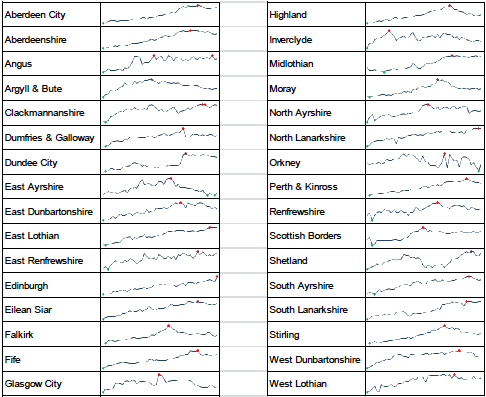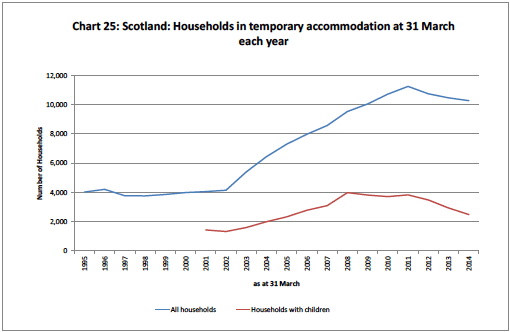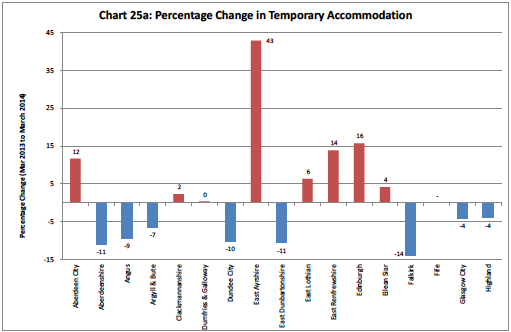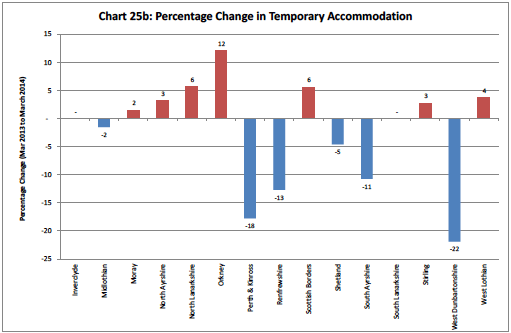Operation of the Homeless Persons Legislation in Scotland: 2013-14
This bulletin provides information on homelessness applications, assessments and outcomes to 31 March 2014. It includes information on the characteristics of applicant households, local authority assessments and the action taken in respect of cases that were concluded. Snapshot data on households in temporary accommodation at 31 March 2014 are also presented.
6. Temporary accommodation (Table 12 to Table 16b and Chart 25 to Chart 26)
6.1. Statistics on numbers of households in temporary accommodation are taken from the HL2 quarterly statistical return by councils [8]. The return provides summary information on households in temporary accommodation at the end of the quarter who have been placed there as a consequence of their homelessness application. Homeless applicants may be placed in temporary accommodation while the council assesses their application or while awaiting the offer of a permanent let. Also, non-priority applicants and those assessed as intentionally homeless may be placed in temporary accommodation and receive advice and assistance as the outcome of their application.
Latest position
At 31 March 2014:-
- There were 10,281 households in temporary accommodation - a decrease of 190 households (2% decrease) compared to one year earlier. (Table 12 and Chart 25).
- There were 2,489 households with children in temporary accommodation - a decrease of 447 households (15% decrease) compared with one year earlier.
Key trends
6.2. The total number of households in temporary accommodation has reduced in each of the last three years - 2012, 2013 and 2014 - and is now at just under 10,300 in 2014. Similarly, the number of households with children in temporary accommodation has also reduced during the last three years - falling by 38% compared to its peak value at the end of March 2008. The number of households with children in temporary accommodation was just under 2,500 at the end of March 2014.
6.3. Chart 25a and Chart 25b shows the percentage increase in households in temporary accommodation between March 2013 and March 2014. It is notable that similar to the previous year there were significant increases in numbers in temporary accommodation in East Lothian and Edinburgh - councils with high proportions of social lets to homeless households. However, the evidence is mixed. For example East Dunbartonshire which has a high percentage of lets to homeless nevertheless saw a significant reduction in numbers in temporary accommodation over the past year. Overall, 15 local authorities have seen an increase in the number of households in temporary accommodation and 14 have seen a decrease.
6.4. The trends in numbers in temporary accommodation are likely to be due to a combination of the impacts of homelessness legislation and, more recently, the impacts of housing options (Chart 26). From 27th January 2014, City of Edinburgh Council started having direct access to additional hostel accommodation. The Council now has access to 199 hostel spaces on a nightly basis and they are available to households who ask for housing advice and / or have a homeless assessment.
6.5. While it is not possible to precisely quantify separate effects, the broad picture over the last ten years looks to be:-
- The increase in the overall number of households without children in temporary accommodation from 2002 was initially driven by homelessness legislation which placed new duties on councils to provide temporary accommodation, advice and assistance for non-priority homeless households. In 2002 the majority of priority homeless were households with children. Following this new duty there was a notable increase in the number of single people applying for homelessness assistance and hence the number in temporary accommodation.
- From 2002 the proportion of homeless applicants assessed as priority increased year on year. This was a direct consequence of homelessness legislation which, among other things, included a target that by 31 December 2012 all unintentionally homeless households would be assessed as being in priority need. Priority homeless households placed in temporary accommodation by councils generally spend significantly longer in temporary accommodation than non-priority homeless. This led to overall increases in numbers in temporary accommodation with the greatest increases for homeless households without children who are mainly single people.
- From 2010 the number of homeless applications has been falling mainly as a consequence of the development of homelessness prevention activities by councils through adopting a 'housing options' approach to meeting acute housing need. This change in practice looks to have contributed to the overall drop in numbers in temporary accommodation between 2011 and 2014.
6.6. During 2013/14, there have been further changes which may impact upon the number of households in temporary accommodation. The availability of the supply of settled accommodation in the locations needed, particularly in the social rented sector, together with the size of available properties required. New restrictions now apply which will impose a housing benefit penalty[9]on those households which live in a property which is too large for their needs. Homeless households which are single or childless couples will typically require a one bedroom property. However, demand for one-bedroom properties is likely to outstrip supply[10]. The number of homeless households in temporary accommodation may increase if homeless households are unable to secure sufficient social sector lets due to competing pressures from others in housing need.
Chart 26: Temporary Accommodation by Local Authority:
30th June 2002 to 31st March 2014

Note: The green markers show the lowest recorded number of households in temporary accommodation over the period 30th June 2002 to 31st March 2014. The red markers show the highest recorded number of households in temporary accommodation.
Types of temporary accommodation used
6.7. The majority of households in temporary accommodation were in local authority or housing association accommodation (64%), with a further 16% in hostels and 11% in bed and breakfast. (Table 12 and Table 13). Households with children or pregnant women are mainly provided with local authority or housing association accommodation (87%), with a small proportion (<1%) being placed in bed and breakfast accommodation. (Table 13)
6.8. On 31 March 2014, there were 11 households with children or pregnant women in bed and breakfast accommodation. The number of households with children in bed & breakfast accommodation is now at just over 9% of the March 2008 level (a 91% fall). (Table 13).
6.9. Use of bed and breakfast accommodation for households with children varies by local authority. On 31 March 2014, 28 local authorities had no households with children in bed & breakfast accommodation, one council had one household with children in bed and breakfast (Moray), two councils had three households with children in bed and breakfast (Aberdeenshire and Fife) and one local authorities had four households with children in bed & breakfast accommodation (West Lothian). (Table 15)
Implementation of the Homeless Persons (Unsuitable Accommodation) (Scotland) Order
6.10. For each quarter from June 2005, councils have reported on the number of households at the end of the quarter who were in unsuitable temporary accommodation and the number where the accommodation provided to the household was in breach of the Unsuitable Accommodation Order. The snapshot figures show that in the quarter ending 31 March 2014:
Contact
Email: Andrew Waugh or Ian Morton
There is a problem
Thanks for your feedback


